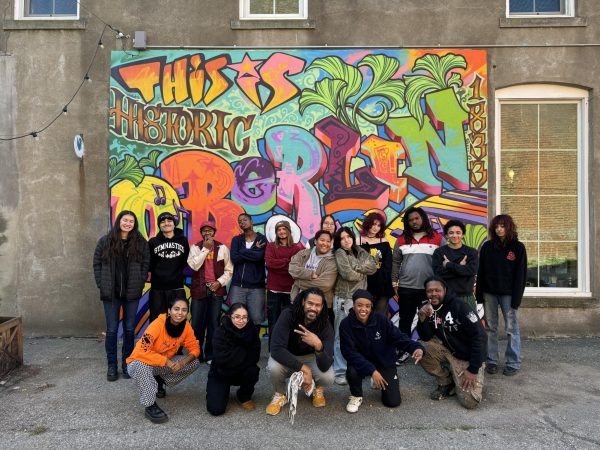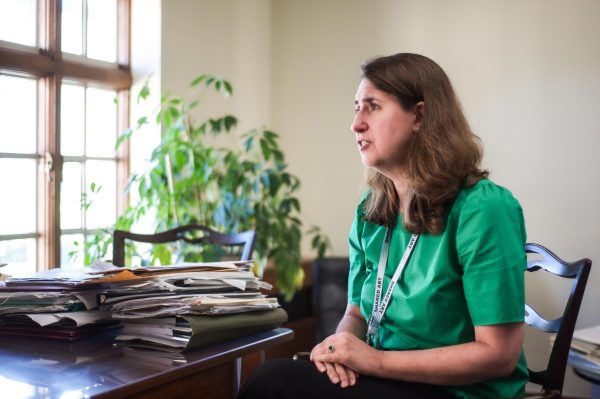Julia Christensen: Professor of Integrated Media and Chair of the Studio Art Department
Photo courtesy of Tanya Rosen-Jones
Last week, Julia Christensen presented her ongoing project, The Tree of Life, a global public art installation consisting of a series of trees that communicate with a spacecraft that will travel into outer space.
Last week, Professor of Integrated Media and Chair of the Studio Art department Julia Christensen presented her ongoing project, The Tree of Life, at the California Institute of Technology. Christensen’s work explores the intersection of art and technology.
This interview has been edited for length and clarity.
You just presented your project, The Tree of Life, at the Interplanetary Small Satellite Conference at Caltech. What is The Tree of Life?
The Tree of Life is a global public art piece that includes a series of living trees around the globe, which we are harnessing to act as living terrestrial antennae that can communicate with a spacecraft we’re designing to push the constraints of obsolescence that are maintained by a capitalist technology structure, to think about technology as long-lasting and sustainable. So that’s the beginning. The trees have sensors on them that are reading data about light, moisture, and temperature, and we are sonifying that data continuously. The tree antennae have been sending out the song about their light, moisture, and temperature experience, and the spacecraft receives that file. Meanwhile, the spacecraft is sending a similar song about its operational experience to the trees. So both songs are put together to make a duet about our life on Earth in conversation with technology that we built.
The whole idea was originally inspired when I was asked to envision an art project to be embedded on an interstellar spacecraft that was conceptually timed to leave Earth in the year 2016. I wanted to create a song or a story from the perspective of trees on earth, rather than from the perspective of humans. A lot of my collaborators are space scientists at the Jet Propulsion Lab in Pasadena, and we formed a nonprofit called The Space Song Foundation to support the project.
Is the focus of The Space Song Foundation to support one project, or was the foundation started to expand on the conversations started by The Tree of Life project?
The mission statement of Space Song is to support The Tree of Life project and explore and expand ideas about design at the intersection of art, science, and technology, to think about sustainable design on Earth and in outer space, because there are a lot of design principles that are designed to do the test or answer a question or finish the experiment, and sometimes that’s just done in a six-month window. The thing that happens to all of that technology when itʼs designed for such a specific function is something we see on Earth all of the time, because we’re dealing with electronics on such an extraordinary scale. The same questions apply to the technology that we’re launching into outer space, and we’re at a point where dead technology is going to create sort of this exoskeleton orbiting our planet. So these questions are super timely. Also, in order to do deep space exploration, to go to another solar system, we need technology that is able to not only travel, you know, 4.2 light years away or whatever, but also operate that entire time. It’ll take decades for a spacecraft to get to a destination that distant, so we also have to be thinking about the long-term operation and technology in order to envision interstellar missions.
So how do we start thinking about sustainable design for space technology?
There’s the spacecraft itself. We have been working with a team of engineers and space scientists since 2018 to develop schematics for CubeSat, a small, toaster-sized spacecraft that can operate for 200 years. The interesting thing about this process is that engineers are trained to think in short timelines, asking, how do we get the data that we need in six months? And so when we made this proposition to them, to design this CubeSat that will last 200 years, they were sort of befuddled — they wanted to know, “Yeah, but what’s it gonna do?” And we said, “Actually, what itʼs going to do is secondary; longevity is the central design intention here.” As soon as the engineers began to embrace that the main test was longevity, it changed the way that weʼre thinking about design.
It often seems that our current culture makes us unable to think long term. Does this make designing with the purpose of longevity difficult?
I think that our public imaginations about the future, in a way, are being constrained by upgrade culture. I wrote a book that was just published a couple of years ago called Upgrade Available about this idea that because the upgrade is always available, it’s hard for us to think long term into the future without consider- ing constant disruption. And so The Tree of Life project is a way of
putting our imagination on a 200-year time scale so we can commit to a future in a way that technology is antithetical to. And with the trees, part of the question that we were asking is if a spacecraft is trying to send us data in 150 years from interstellar destination, how are we going to receive that data? How do we get a JPEG in the year 2250? So, we started to think about how we really need to look back at earlier technological systems, to think about fidelity in the long term. Radio just kept coming back. You know, a radio wave is a radio wave, it’s not going to become obsolete. We can change the way that we transmit it or receive it, but if the laws of physics are true across the universe, which we think they are, a sine wave is a sine wave. My colleagues who work on NASA projects, they love this project, because it’s so Back to the Future. We have to look back to look forward.
What do you think being an artist doing this work provides to these conversations of technology? Does it take an artistic eye to design something that reimagines current perceptions of longevity?
Recently, somebody was introducing me at a talk and they called me an embedded artist. I’ve never really thought about that term in relation to myself, but I kind of like it because it’s sort of like embedding an artist at the table with people who are trying to solve some other kind of problem. Some of my engineer colleagues say that artists help them think through their thinking, because we can slow things down. We’re like, “Well, why don’t we just make it empty?” Also, I think that having an artist in the room empowers scientists to see the work that they’re doing as creative, you know, and not so analytical. I mean, working with my colleagues in Space Song, I think it helps them see that really, weʼre all kind of on this existential plane of asking these questions about who we are and where we are.
ast week, Professor of Integrated Media and Chair of the Studio Art department Julia Christensen presented her ongoing project, The Tree of Life, at the California Institute of Technology. Christensen’s work explores the intersection of art and technology.
This interview has been edited for length and clarity.
You just presented your project, The Tree of Life, at the Interplanetary Small Satellite Conference at Caltech. What is The Tree of Life?
The Tree of Life is a global public art piece that includes a series of living trees around the globe, which we are harnessing to act as living terrestrial antennae that can communicate with a spacecraft we’re designing to push the constraints of obsolescence that are maintained by a capitalist technology structure, to think about technology as long-lasting and sustainable. So that’s the beginning. The trees have sensors on them that are reading data about light, moisture, and temperature, and we are sonifying that data continuously. The tree antennae have been sending out the song about their light, moisture, and temperature experience, and the spacecraft receives that file. Meanwhile, the spacecraft is sending a similar song about its operational experience to the trees. So both songs are put together to make a duet about our life on Earth in conversation with technology that we built.
The whole idea was originally inspired when I was asked to envision an art project to be embedded on an interstellar spacecraft that was conceptually timed to leave Earth in the year 2016. I wanted to create a song or a story from the perspective of trees on earth, rather than from the perspective of humans. A lot of my collaborators are space scientists at the Jet Propulsion Lab in Pasadena, and we formed a nonprofit called The Space Song Foundation to support the project.
Is the focus of The Space Song Foundation to support one project, or was the foundation started to expand on the conversations started by The Tree of Life project?
The mission statement of Space Song is to support The Tree of Life project and explore and expand ideas about design at the intersection of art, science, and technology, to think about sustainable design on Earth and in outer space, because there are a lot of design principles that are designed to do the test or answer a question or finish the experiment, and sometimes that’s just done in a six-month window. The thing that happens to all of that technology when itʼs designed for such a specific function is something we see on Earth all of the time, because we’re dealing with electronics on such an extraordinary scale. The same questions apply to the technology that we’re launching into outer space, and we’re at a point where dead technology is going to create sort of this exoskeleton orbiting our planet. So these questions are super timely. Also, in order to do deep space exploration, to go to another solar system, we need technology that is able to not only travel, you know, 4.2 light years away or whatever, but also operate that entire time. It’ll take decades for a spacecraft to get to a destination that distant, so we also have to be thinking about the long-term operation and technology in order to envision interstellar missions.
So how do we start thinking about sustainable design for space technology?
There’s the spacecraft itself. We have been working with a team of engineers and space scientists since 2018 to develop schematics for CubeSat, a small, toaster-sized spacecraft that can operate for 200 years. The interesting thing about this process is that engineers are trained to think in short timelines, asking, how do we get the data that we need in six months? And so when we made this proposition to them, to design this CubeSat that will last 200 years, they were sort of befuddled — they wanted to know, “Yeah, but what’s it gonna do?” And we said, “Actually, what itʼs going to do is secondary; longevity is the central design intention here.” As soon as the engineers began to embrace that the main test was longevity, it changed the way that weʼre thinking about design.
It often seems that our current culture makes us unable to think long term. Does this make designing with the purpose of longevity difficult?
I think that our public imaginations about the future, in a way, are being constrained by upgrade culture. I wrote a book that was just published a couple of years ago called Upgrade Available about this idea that because the upgrade is always available, it’s hard for us to think long term into the future without consider- ing constant disruption. And so The Tree of Life project is a way of
putting our imagination on a 200-year time scale so we can commit to a future in a way that technology is antithetical to. And with the trees, part of the question that we were asking is if a spacecraft is trying to send us data in 150 years from interstellar destination, how are we going to receive that data? How do we get a JPEG in the year 2250? So, we started to think about how we really need to look back at earlier technological systems, to think about fidelity in the long term. Radio just kept coming back. You know, a radio wave is a radio wave, it’s not going to become obsolete. We can change the way that we transmit it or receive it, but if the laws of physics are true across the universe, which we think they are, a sine wave is a sine wave. My colleagues who work on NASA projects, they love this project, because it’s so Back to the Future. We have to look back to look forward.
What do you think being an artist doing this work provides to these conversations of technology? Does it take an artistic eye to design something that reimagines current perceptions of longevity?
Recently, somebody was introducing me at a talk and they called me an embedded artist. I’ve never really thought about that term in relation to myself, but I kind of like it because it’s sort of like embedding an artist at the table with people who are trying to solve some other kind of problem. Some of my engineer colleagues say that artists help them think through their thinking, because we can slow things down. We’re like, “Well, why don’t we just make it empty?” Also, I think that having an artist in the room empowers scientists to see the work that they’re doing as creative, you know, and not so analytical. I mean, working with my colleagues in Space Song, I think it helps them see that really, weʼre all kind of on this existential plane of asking these questions about who we are and where we are.








